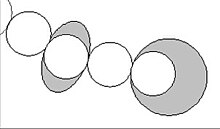가상 행성 연구소
Virtual Planetary Laboratory이 기사의 외부 링크 사용은 위키피디아의 정책이나 지침을 따르지 않을 수 있다. (2020년 8월)(이과 시기 |
| 약어 | VPL |
|---|---|
| 포메이션 | 2001 |
| 법적현황 | 활동적인 |
| 목적 | 외부 행성 거주성 및 잠재적 생물학적 특성을 탐지한다. |
모조직 | 나사 |
| 웹사이트 | 가상 행성 연구소 |
VPL(Virtual Planet Laboratory, VPL)은 워싱턴 대학교에 기반을 둔 가상 연구소로, 외부 행성 거주성과 그 잠재적 생물학적 특성을 탐지하는 방법을 연구한다. 2001년에 처음 결성된 VPL은 NASA Astrobiology Institute(NAI)의 일부로서 학제간 노력으로 20개 기관의 50명 이상의 연구자를 연결한다. VPL은 NEXSS(Nexus for Exoplanet System Science) 네트워크의 일부로서 NExSS VPL 팀을 이끄는 수석 조사관 빅토리아 메도우스가 있다.[1][2]
리서치
과제 A: 태양계 외부 행성 관찰 아날로그
첫 번째 과제는 태양계 행성, 달, 소행성대에 대한 관측을 고려하여 거주 가능한 환경과 외부 행성 모델 확인에 필요한 과정을 탐구한다. 구체적으로, 유로파,[3] 금성,[4] 지구,[5] 화성, 소행성대에 대한 관측은 과제 A의 연구자들이 그들의 목표를 다루는 데 도움을 주었다.
과제 B: 시간을 통한 지구
오늘날 우리가 거주할 수 있는 행성의 유일한 데이터 지점은 지구다. 하지만, 우리 행성이 항상 거주할 수 있었던 것은 아니다. 초기 지구는 외부 행성의 예시 역할을 한다. VPL 연구는 초기 행성을 이해하는 데 기여했다. 과제 B는 지질학적, 생물학적 데이터와[6] 생태계[7], 광화학 모델을[8][9] 결합해 지구가 역사 전반에 걸쳐 어떻게 변화해 왔는지를 보여준다.
과제 C: 거주할 수 있는 행성
이 과제는 우주에서 거주할 수 있는 세계의 분포를 탐구하기 위해 관측 데이터, 모델 및 궤도 역학을 사용한다. VPL 팀은 은하,[10] 항성 및 [11]행성 환경이[12] 행성 거주성에 미치는 영향을 연구한다.
과제 D: 살아있는 행성
과제 D는 생물이 환경에 미치는 영향을 연구하기 위해 화학 및 기후 모델과 결합된 실험실 작업을[13][14] 사용하는 다양하고 학제간 분야의 VPL 연구자를 통합한다. 또한 생물권, 행성 및 숙주별 간의 상호작용을 탐구하여 탐지 가능한 바이오시그니쳐에 어떻게 영향을 미칠 수 있는지 결정한다.[15]
과제 E: 관찰자
마지막 과제에서 VPL 과학자들은 태양계와 극외 행성을 관찰한다. 이 과제의 목표는 천문학적[16], 원격 감지 검색 방법을 개발하는 것이다. 또한 VPL 회원은 망원경 및 계기 시뮬레이터를 사용하여 외부 행성의 특성화에 필요한 측정, 관측 전략, 분석 기법을 연구한다.[17]
모델
교육 & 홍보
뉴스 속 VPL
2017년 2월 - 흐릿한 외부 행성의 대용품으로 초기 지구
2016년 8월 - Proxima Centauri b는 거주할 수 있는가?[18][19]
참고 항목
참조
- ^ 임피, 크리스(2010). 삶에 대한 이야기: 우주 생물학에 대한 대화. 케임브리지 대학 출판부 293-302쪽 ISBN9781139490634.
- ^ 켈리, 피터 (2015년 4월 22일) "멀리 먼 세계의 생명체를 찾기 위한 새로운 NASA 연합의 핵심 참가국" UW 뉴스. 2015년 5월 4일 회수.
- ^ Robinson, Tyler D. (January 1, 2011). "Modeling the Infrared Spectrum of the Earth-Moon System: Implications for the Detection and Characterization of Earthlike Extrasolar Planets and Their Moonlike Companions". The Astrophysical Journal. 741 (1): 51. arXiv:1110.3744. Bibcode:2011ApJ...741...51R. doi:10.1088/0004-637X/741/1/51. S2CID 119281936 – via Institute of Physics.
- ^ Arney, Giada; Meadows, Victoria; Crisp, David; Schmidt, Sarah J.; Bailey, Jeremy; Robinson, Tyler (August 1, 2014). "Spatially resolved measurements of H2O, HCl, CO, OCS, SO2, cloud opacity, and acid concentration in the Venus near-infrared spectral windows". Journal of Geophysical Research: Planets. 119 (8): 2014JE004662. Bibcode:2014JGRE..119.1860A. doi:10.1002/2014JE004662.
- ^ Robinson, Tyler D.; Meadows, Victoria S.; Crisp, David; Deming, Drake; A'Hearn, Michael F.; Charbonneau, David; Livengood, Timothy A.; Seager, Sara; Barry, Richard K.; Hearty, Thomas; Hewagama, Tilak; Lisse, Carey M.; McFadden, Lucy A.; Wellnitz, Dennis D. (2011). "Earth as an Extrasolar Planet: Earth Model Validation Using EPOXI Earth Observations". Astrobiology. 11 (5): 393–408. Bibcode:2011AsBio..11..393R. doi:10.1089/ast.2011.0642. PMC 3133830. PMID 21631250.
- ^ Claire, M. W.; Catling, D. C.; Zahnle, K. J. (December 1, 2006). "Biogeochemical modelling of the rise in atmospheric oxygen". Geobiology. 4 (4): 239–269. doi:10.1111/j.1472-4669.2006.00084.x.
- ^ Roberson, A. L.; Roadt, J.; Halevy, I.; Kasting, J. F. (July 1, 2011). "Greenhouse warming by nitrous oxide and methane in the Proterozoic Eon". Geobiology. 9 (4): 313–320. doi:10.1111/j.1472-4669.2011.00286.x. PMID 21682839.
- ^ Zerkle, Aubrey L.; Claire, Mark W.; Domagal-Goldman, Shawn D.; Farquhar, James; Poulton, Simon W. (May 1, 2012). "A bistable organic-rich atmosphere on the Neoarchaean Earth". Nature Geoscience. 5 (5): 359–363. Bibcode:2012NatGe...5..359Z. doi:10.1038/ngeo1425.
- ^ Claire, Mark W.; Kasting, James F.; Domagal-Goldman, Shawn D.; Stüeken, Eva E.; Buick, Roger; Meadows, Victoria S. (September 15, 2014). "Modeling the signature of sulfur mass-independent fractionation produced in the Archean atmosphere" (PDF). Geochimica et Cosmochimica Acta. 141: 365–380. Bibcode:2014GeCoA.141..365C. doi:10.1016/j.gca.2014.06.032.
- ^ Kaib, Nathan A.; Raymond, Sean N.; Duncan, Martin (January 17, 2013). "Planetary system disruption by Galactic perturbations to wide binary stars". Nature. 493 (7432): 381–384. arXiv:1301.3145. Bibcode:2013Natur.493..381K. CiteSeerX 10.1.1.765.6816. doi:10.1038/nature11780. PMID 23292514. S2CID 4303714.
- ^ Segura, Antígona; Walkowicz, Lucianne M.; Meadows, Victoria; Kasting, James; Hawley, Suzanne (September 1, 2010). "The Effect of a Strong Stellar Flare on the Atmospheric Chemistry of an Earth-like Planet Orbiting an M Dwarf". Astrobiology. 10 (7): 751–771. arXiv:1006.0022. Bibcode:2010AsBio..10..751S. doi:10.1089/ast.2009.0376. PMC 3103837. PMID 20879863.
- ^ Kopparapu, R. K.; Raymond, S. N.; Barnes, R. (2009). "Stability of Additional Planets in and Around the Habitable Zone of the HD 47186 Planetary System". The Astrophysical Journal Letters. 695 (2): L181–L184. arXiv:0903.3597. Bibcode:2009ApJ...695L.181K. doi:10.1088/0004-637x/695/2/l181. S2CID 17136043.
- ^ Anderson, Rika E.; Sogin, Mitchell L.; Baross, John A. (January 1, 2015). "Biogeography and ecology of the rare and abundant microbial lineages in deep-sea hydrothermal vents". FEMS Microbiology Ecology. 91 (1): 1–11. doi:10.1093/femsec/fiu016. hdl:1912/7205. PMID 25764538.
- ^ Breitbart, Mya; Hoare, Ana; Nitti, Anthony; Siefert, Janet; Haynes, Matthew; Dinsdale, Elizabeth; Edwards, Robert; Souza, Valeria; Rohwer, Forest; Hollander, David (January 1, 2009). "Metagenomic and stable isotopic analyses of modern freshwater microbialites in Cuatro Ciénegas, Mexico". Environmental Microbiology. 11 (1): 16–34. doi:10.1111/j.1462-2920.2008.01725.x. PMID 18764874.
- ^ Domagal-Goldman, Shawn D.; Meadows, Victoria S.; Claire, Mark W.; Kasting, James F. (June 1, 2011). "Using biogenic sulfur gases as remotely detectable biosignatures on anoxic planets". Astrobiology. 11 (5): 419–441. Bibcode:2011AsBio..11..419D. doi:10.1089/ast.2010.0509. PMC 3133782. PMID 21663401.
- ^ Schwieterman, Edward W.; Meadows, Victoria S.; Domagal-Goldman, Shawn D.; Deming, Drake; Arney, Giada N.; Luger, Rodrigo; Harman, Chester E.; Misra, Amit; Barnes, Rory (January 1, 2016). "Identifying Planetary Biosignature Impostors: Spectral Features of CO and O4 Resulting from Abiotic O2/O3 Production". The Astrophysical Journal Letters. 819 (1): L13. arXiv:1602.05584. Bibcode:2016ApJ...819L..13S. doi:10.3847/2041-8205/819/1/L13. PMC 6108182. PMID 30147857.
- ^ Luger, Rodrigo; et al. (March 12, 2017). "A terrestrial-sized exoplanet at the snow line of TRAPPIST-1". Nature Astronomy. 1 (6): 0129. arXiv:1703.04166. Bibcode:2017NatAs...1E.129L. doi:10.1038/s41550-017-0129. S2CID 54770728.
- ^ Meadows, V. S.; Arney, G. N.; Schwieterman, E. W.; Lustig-Yaeger, J.; Lincowski, A. P.; Robinson, T.; Domagal-Goldman, S. D.; Deitrick, R.; Barnes, R. K.; Fleming, D. P.; Luger, R.; Driscoll, P. E.; Quinn, T. R.; Crisp, D.; et al. (August 30, 2016). "The Habitability of Proxima Centauri b: II: Environmental States and Observational Discriminants". Astrobiology. 18 (2): 133–189. arXiv:1608.08620. Bibcode:2018AsBio..18..133M. doi:10.1089/ast.2016.1589. PMC 5820795. PMID 29431479.
- ^ Barnes, Rory; et al. (August 24, 2016). "The Habitability of Proxima Centauri b I: Evolutionary Scenarios". arXiv:1608.06919 [astro-ph.EP].



